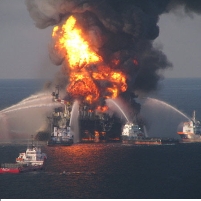Why Did Leaking Oil Rig Lack Safety Switch Used in Other Countries?
Wednesday, May 05, 2010
 Deepwater Horizon (photo: U.S. Coast Guard)
Deepwater Horizon (photo: U.S. Coast Guard)
Oil-producing nations Norway and Brazil both require the use of a remote-control shut-off switch for offshore oil platforms—something the Deepwater Horizon in the Gulf of Mexico, as well as other drilling operations off the United States’ coasts, are not mandated to use.
Following complaints about costs and the usefulness of the $500,000 acoustic trigger device, the Minerals Management Service (MMS) decided not to require oil and drilling companies to buy the equipment. MMS officials said oil platforms already had shutoff systems in place to prevent blowouts.
The Deepwater Horizon was supposedly equipped to stop crude oil, which is now threatening to pollute the Gulf coast, from gushing uncontrollably into the sea.
Meanwhile, congressional lawmakers plan to talk to the heads of Halliburton about the construction work the company performed in setting up the offshore platform which exploded and sank in April. At issue is the cementing work Halliburton did on the sea floor to secure the drill.
Halliburton is being investigated in Australia for allegedly performing poor cement work on a job that led to a major blowout in the Timor Sea last summer.
According to The Wall Street Journal, the MMS reported in 2007 that cementing was a factor in 18 of 39 well blowouts in the Gulf of Mexico between 1992 and 2006.
-Noel Brinkerhoff
Leaking Oil Well Lacked Safeguard Device (by Russell Gold, Ben Casselman and Guy Chazan, Wall Street Journal)
Halliburton in Spotlight in Gulf Spill Probe (by Margot Roosevelt, Los Angeles Times)
- Top Stories
- Unusual News
- Where is the Money Going?
- Controversies
- U.S. and the World
- Appointments and Resignations
- Latest News
- Trump to Stop Deportations If…
- Trump Denounces World Series
- What If China Invaded the United States?
- Donald Trump Has a Mental Health Problem and It Has a Name
- Trump Goes on Renaming Frenzy






Comments